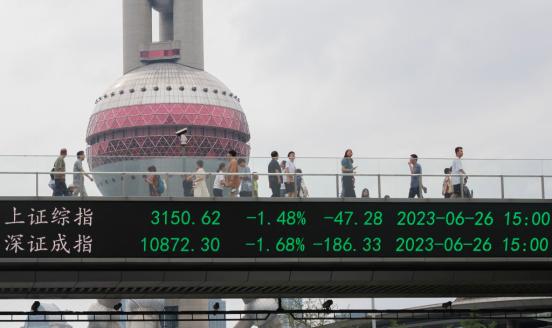Toward a smart Indian response to China
Rather than risking its soldiers' lives on the border, India should join 'middle power' economic coalitions to address China's behavior.
The Indian government is under massive pressure to retaliate economically for the deaths of Indian soldiers in a border clash with China. While some bilateral measures may be unavoidable, India’s long-term interest is to join coalitions of countries addressing specific aspects of Chinese economic behavior.
In an important address to the nation on May 12, Prime Minister Narendra Modi articulated his vision of a “self-reliant” India: engaged with the world, but dedicated to using domestic resources to meet domestic needs.
The speech was delivered as India was dealing with the enormous medical, economic and humanitarian impact of the Covid-19 pandemic. While few details are yet available, what is clear is that Modi was offering a different vision from India’s commitment to liberal global integration over the last 30 years. The world had changed, India had changed, the ruling party had changed. What had been tried in the past was insufficient to make the 21st century “India’s century.”
India had been reassessing its global economic engagement since Modi’s electoral triumph in May 2019, which saw his Bharatiya Janata Party (BJP, or Indian People’s Party) return to power with the rare achievement of an enhanced, absolute majority in Parliament.
Driving this reassessment were slowing economic growth and poor export performance in the run-up to the election. This indifferent performance had revived the strong tradition of economic nationalism within the BJP. But central to the review was the economic and strategic relationship with China.
Beijing’s strong military and financial support of India’s rival Pakistan had caused New Delhi to reject repeated invitations to join China’s signature Belt and Road Initiative. All of this was against the background of a series of unresolved disputes at various points on the long border with China, the source of a brief war in 1962, which was seen as a defeat for India.
These bilateral economic misgivings were compounded by a more assertive posture taken by Beijing on security matters in the South China Sea and, increasingly, the Indian Ocean, both waterways of considerable significance to India.
Even as Modi spoke, trouble was brewing along the arc of India’s border with China. The two sides had managed to maintain an uneasy peace for 40 years, but a border clash on June 15 the Ladakh sector led to the deaths of 20 Indian soldiers. As both governments work to defuse the situation, the loss of military lives has vastly amplified earlier calls for India to reduce sharply its economic engagement with China.
There is significant asymmetry in the bilateral economic relationship. From rough parity 30 years ago, the Chinese economy is now five times as large as India’s (when measured in US dollars at current market prices). China looms large in Indian trade and investment; the reverse is much less the case, although the potential scale of the market and India’s capacity for innovation have been a draw for Chinese companies.
For its part, India had actively encouraged Chinese trade and investment flows, but it was not able to get official redress on long-standing concerns about a large imbalance in trade in goods and barriers to market access for export in services where it is more competitive.
The persistence of the imbalance has led to accusations that China’s trade goals were mercantilist, state-led and predatory. These concerns have led India to invoke remedies available to it under the World Trade Organization (WTO).
Indian security analysts criticized the government for permitting China to “hollow out” India’s already weak manufacturing sector and have accused the government of “appeasement” in its attempts to lure Chinese capital. Despite these criticisms, Modi invested substantial political capital in ties with Chinese President Xi Jinping, including bilateral working visits in both directions.
An important marker of New Delhi’s deepening concerns was the decision announced by Modi while at a summit in Bangkok last November, that India would not participate in the final negotiations of the Regional Comprehensive Economic Partnership (RCEP), eight years after the negotiations were launched.
This is a draft trade agreement between the 10 ASEAN (Association of Southeast Asian Nations) countries and six regional partners (China, Japan, South Korea, India, Australia and New Zealand) and would have been the first to include both India and China. Press reports indicate that the Indian government was lacked domestic political support for an agreement that included China.
More recently, India has put in place regulatory restrictions on portfolio investment by Chinese companies in Indian-domiciled firms.
What then should guide India’s economic stance toward China at this crucial juncture? Three assumptions guide our thinking.
First, that both sides will prevent the unfortunate encounter at Ladakh from tipping into war and that both countries would wish to maintain the separation of the security and economic spheres that has prevailed up to now.
Second, that the limited trust of the Indian public in China’s word has been eroded, and that this is now the political reality for the Modi government.
Third, despite the aggressiveness of Chinese behavior – economic and military – in other parts of Asia, the Indian leadership is not about to condemn China as an economic pariah.
In common with some Indian economic commentators we believe that India has the scale and sophistication to recalibrate the economic relationship with China such that deeper interdependence reduces and does not increase India’s economic vulnerability.
We also note that, measured (as the International Monetary Fund does) by purchasing power parity, we are talking of the largest and third-largest economies on the planet. Both are seriously enfeebled by the Covid-19 pandemic, and poorly equipped to handle the further shock of any rapid economic disengagement. Yet, for India, business-as-usual is even less a politically realistic option than it was before Modi’s May 12 speech.
If our assumptions and premises are accepted, and if India wishes to maintain distance from both the US and China, then its best option is to engage actively and aggressively with coalitions of “middle powers” that share some of India’s concerns on non-market behavior of Chinese entities while maintaining commercial contact with China.
Foremost among these is the European Commission, which has been working with member states of the European Union (and with the WTO) to develop disciplines on state-owned enterprises and investments in strategic sectors without imposing blanket bans, though similar disciplines may then be imposed on India in its own negotiations with the EU.
Were India to reconsider re-engaging with RCEP, this would allow it to cooperate with Japan, Australia and South Korea in fashioning the relevant rules.
As the saying goes, for things to stay the same, everything needs to change. Deaths at the Ladakh border may require the Modi government to undertake a radical rethink of its path to self-reliance.




